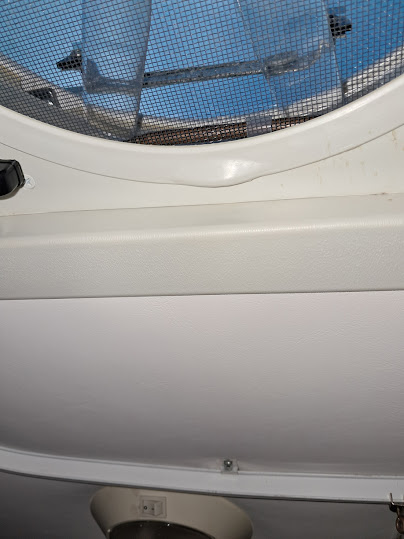There are times that the screen on the Fantastic Fan on the ceiling of the Roadtrek needs to be removed. The screen seems very fragile when taking it off the fan base, but if you are careful and follow this simple process it is easy.
Why would you need to do this? When the fan lid is opened the support arm that opens the fan lid when you turn the knob pushes a switch that will let the fan turn on. If the lid is closed the fan will not turn on. The lid must be at least 1/3 open for the fan to turn on. What controls this is a small switch that when the support arm passes the switch turns that little switch on and the fan can then be turned on. There are times when that switch gets stuck and the fan will not go on. Rather than having to go up to the roof of the Roadtrek outside and work on the fan with the lid open - by taking the fan screen off - you have access to all that you need to get to when fixing this.
In the photo above you will see a bump out on the plastic frame of the fan screen. There is a small opening under the bump out that you can get a finger tip into.
1. Put a finger tip into the opening below the bump out and gently pull down. That part of the fan screen frame will come down a small amount.
2. Move your finger around between the screen and the fan case gently around the entire circle of the screen. Don't pull it down - that can damage. Go all around the entire screen frame separating it from the fan base. The screen will then come off and into your hands.
THE SCREEN IS NOW OFF! 😃
With it off you can work within the frame. Just push the blade around and out of your way to get to what you need to get to.
Taking it off means you are going to have to put it back on!
All you have to do is reverse what you did to take it off.
1. Put the screen up into the hole and at the bump out push that edge up into the opening so that the edge of the screen is on the base of the fan.
2. Again gently - go around the edge of the screen frame and push it back on all around the edge. It will snap into place as you go.
THAT IS IT!
At one point the fan in our Roadtrek was not working. It would not turn on even when the lid was fully open. I figured that the fan would have to replaced or I would have to take it to an RV shop to get it fixed. I read about the little switch and decided that I could see if I could fix it. That was when I saw how to remove the screen without breaking it - and I was reading posts on forums about how easily they break. Turns out the support arm was hard opening and was missing the little switch. I lubed the support arm joints with a silicone gel lubricant (Dielectric grease) from a tube - put on a cotton swap to apply it and straightened the support arm to do its job with the switch. No need to go on the roof. No need to take it to be fixed or replaced - saving some money.


